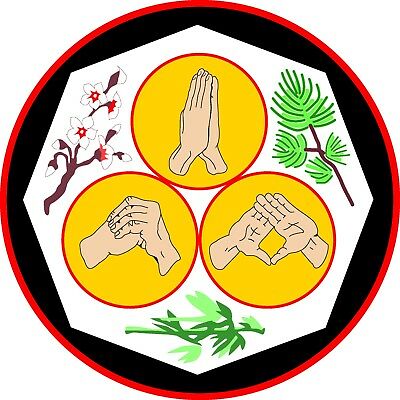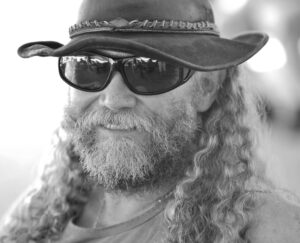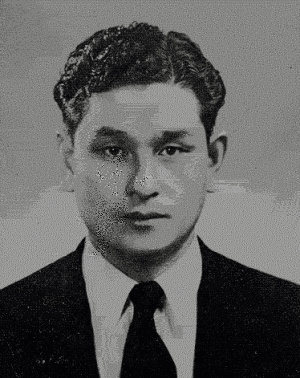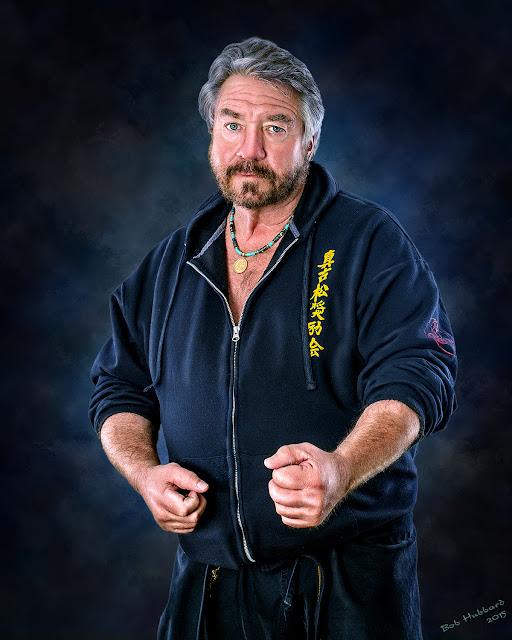Sho Chiku Bai Mon

The Sho Chiku Bai Mon (Pine, Bamboo, Plum Crest) is the basic foundation of study for all Kosho Ryu practitioners, and for that matter, all traditional martial artists. The study of the Mon is known as Mon Gaku.
The Sho Chiku Bai crest of Kosho Ryu has elements that are over 750 years old.
Crests that are developed in modern times do not have the roots and historical significance represented in the Sho Chiku Bai. There are three ways of looking at the crest and its meaning. Interpretation is taught in order of importance as follows.
The spiritual and philosophical study is most important. This study has a tendency to keep the practitioner in line with his environment and himself in relation to any potential conflict. We must understand that we are responsible for everything we do as human beings. The second representation is that of the physical study. This study deals with avoidance of direct physical conflict with any individual. We can manipulate either body movement or body position so that we may escape harm. This is the highest level of study in Kosho relating to the physical arts: to do no harm.
The third representation is the study of destructive arts. These arts are utilized only when there is no alternative. The study of this particular aspect of Kosho Ryu is the most important, and yet the least important. Kosho Ryu is a philosophical art. We must understand that it stems from the study of Zen. Zen Buddhism is the study of who we are in relation to nature, ourselves, those around us, and our environment. The philosophy of Zen is awareness of everything around us and ourselves. Thus, the importance of the study of the Sho Chiku Bai.
- First Representation: The right hand (representing the physical) and the left hand (representing the spiritual) are placed together for peace and avoidance of conflict.
- Second Representation: Escaping Arts
- Third Representation: Skeletal Strikes
- First Representation: The right hand and left hand are placed together in the shape of a mountain. Look for the good in man as you would see a mountain from a distance, without nitpicking flaws and imperfections.
- Second Representation: Folding Arts
- Third Representation: Internal Strikes
- First Representation: The right hand (representing physical skills) is covered by the left hand (representing spiritual skills). One should temper his actions with morality, avoid conflict, and hide his weapons.
- Second Representation: Muscular Strikes
- Third Representation: Total Domination
Evergreens live long, young, and healthy lives. The pine symbolizes faithful friendship which resists all trials. The pine represents the religion of Taoism. The Japanese people use pine needles for ornaments on Christmas and New Year.
Bamboo represents Honesty. When you cut into bamboo, you find emptiness inside. Nothing evil is hidden within. Also, Kosho Ryu practitioners remain ever empty, and open to additional knowledge, never becoming full of themselves and their accomplishments. The bamboo is the symbol of the application of discipline and the man who remains loyal in all events. Bamboo represents the Japanese religion of Buddhism.
The Japanese plum flower stands for beauty, nobility, and courage. This is because the plum flower puts forth blossoms while the snow is still on the ground. The plum tree flowers before all the others. The Japanese people love the plum fruit. They especially eat plums when they are sick. Plum represents the Japanese religion of Shintoism.
The Octagon is perhaps the most important aspect of the Mon in the study of the physical arts.
First Representation: The Eight fold Path of Buddhism:
- Right Speech
- Right Understanding
- Right Means of Livelihood
- Right Effort
- Right Meditation
- Right Action
- Right Intention
- Right Awareness
Second Representation: Mon Gaku, the Study of the Crest.
Third Representation: Hakkakkei Densho Gaku, Ethical Study of the Octagon.
Juchnik Hanshi goes into great detail on the Octagon, the Eight fold Path, Mon Gaku, and Hakkakkei Densho Gaku in his first book, The Last Disciple, pages 95 to 171. He relates the philosophies briefly touched upon here to physical arts, strategies and philosophies of solving conflict. This book is strongly recommended to anyone seriously studying Kosho Ryu.
The above categories, Energy Collection, Healing Arts, Japanese Yoga, Escaping Arts, Philosophy, Folding Arts, Meditation, and War Arts, are the major areas of study within Kosho Ryu. In each category, the practitioner will find endless study.
- Angle One: Energy Collection. Energy Collection includes, but is not limited to the study of breathing, posture, triangulation of alignments, timing, visualization, energy gathering and projection exercises, Kata, kumite, and Bunkai.
- Angle Two: Healing Arts. Healing Arts include, but are not limited to the study of the Five Element Theory, anatomy, physiology, body systems, shiatsu, anma, nutrition, herb-ology, the study of boshin, bunshin, munshin, and setsushin (diagnostic techniques), posture, energy projection and gathering, Kata, kumite, and Bunkai.
- Angle Three: Japanese Yoga. Japanese Yoga includes, but is not limited to the study of stretching and conditioning exercises designed specifically for the study of the Kosho Ryu martial arts as well as for general fitness, breathing, posture, triangulation of alignments, timing, visualization, energy gathering and projection exercises, Kata, kumite, and Bunkai.
- Angle Four: Escaping Arts. Escaping Arts include, but are not limited to the study of breathing, posture, natural movement, triangulation of alignments, timing, jumping patterns, angling, eye training with respect to cutting down negative stimuli in reactions, falling techniques, hearing arts, arts of reading the opponent's intent, the study of metabolism, Kata, kumite, and Bunkai..
- Angle Five: Philosophy.Philosophy includes, but is not limited to the study of the Mon, and of culture, history, awareness of the physical self, awareness of the spiritual self, Kata, kumite, and Bunkai.
- Angle Six: Folding Arts. Folding Arts include, but are not limited to the study of fundamental throwing techniques, fundamental releasing techniques, fundamental ground techniques, breathing, leverage, anatomy, natural movement, entering motion, engagement and disengagement with a moving opponent, kyo and jitsu, Kata, kumite, and Bunkai..
- Angle Seven: Meditation. Meditation includes, but is not limited to the study of Shodo (Japanese Brush Calligraphy), Ikebana (Japanese Flower Arranging), Iaido (swordsmanship practice for the sharpening of the mind and spirit), comprehensive understanding of philosophy and energy collection, history, understanding of kokoro, kime (focus), Kata, kumite, and Bunkai..
- Angle Eight: War Arts. War Arts include, but are not limited to the study of strategy, timing, posture and posturing, angling, combative distancing, Kenjutsu (Japanese fencing), Iaijutsu (swordsmanship with combative application done from the sheathed posture), Naginatajutsu (Halberd arts), Sojutsu (Spearmanship), Bojutsu (long staff arts), Jojutsu (short staff arts), Tantojutsu (knife arts), natural movement, vital point striking techniques, muscular strikes, skeletal strikes and bone smashing, nerve strikes, internal strikes, breathing, triangulation of alignments, energy gathering and projection exercises, Kata, kumite, and Bunkai.
This is the basis for a lifetime of study! here do you begin? The first step is with my Introduction to Kosho Ryu Video Course which is part of the Kosho Core Concepts Series. And if you are not yet sure you are ready then grab a copy of my Free Kosho Ryu Video!
Thank you for your time!
Yours in the arts,
Grand Master Art Mason


